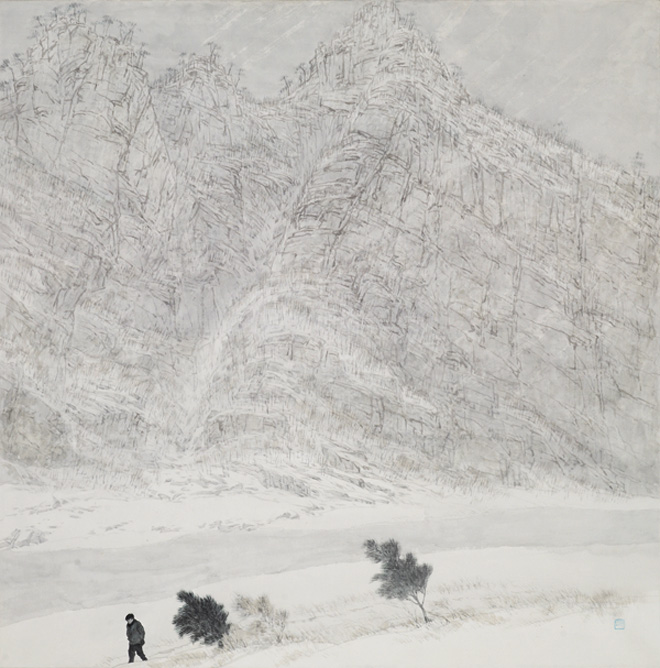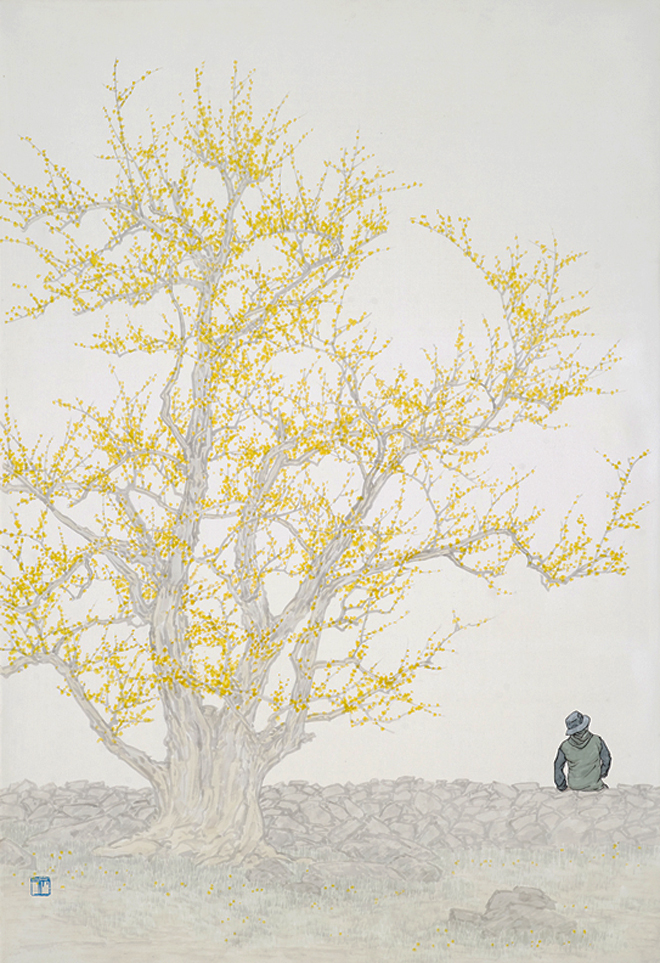
The exhibition "Blurry Scene" presents atmospheric landscape works where wild pristine nature is shrouded in falling snow and low misty clouds hover over the horizon, establishing a sense of silence and solitude. While Lim's touch with ink on paper is steeped in the tradition of the Asian masters, his art is linked as well to the landscape tradition of Western artists whose longing to be one with nature strikes a cord with Lim's vision. In many cultures, mountains are said to represent the spiritual forces that inhabit the landscape where earth and heaven are believed to merge. Cézanne's preeminent connection with the iconic Mont Sainte-Victoire parallels Lim's attraction to the vertical sweep of the mountain in his snowy vista ("Dong River," oriental ink mounted on rice paper with sealed white porcelain powder, 2016) that dwarfs a small figure by its majestic towering tiers.
Like Cézanne, Lim uses pine trees to anchor and stabilize the focus of compositions where sky and sea connect in a hazy undefined relationship set at the picture's horizon. The trees ("Waiting for Spring," oriental ink and color on white porcelain powder, 2016) function as metaphorical beacons, overlooking wavy water seen in the distance past sheets of fluttering vegetation swaying in a grassy field. In China, pine trees symbolize the winter season and human longevity. In folklore, the resin from pines trees is said to have healing powers that foster associations with resurrection and fertility. The trees act as companions for the single figure situated in a deserted area; when we are alone we find our senses becoming sharper, more perceptive and observant. Lim's images spur questions about being and the meaning of existence. The richness of nature in its seasonal guises, whether frozen white or draped in the fragrance of flowers, hones and rejuvenates the frayed self that becomes frazzled in the midst of an urban blight of noise, air pollution, traffic and jostling crowds. Discovery of the smallest snowflake reaffirms one's connection with the infinite world of the eternal.
Close tones and the diffused use of saturated color suggest parallels with works by both Monet and Puvis DeChavannes. Monet studied haystacks and a cathedral facade at various times of day in order to capture the evanescent mutative forces that natural luminosity sheds on the world. Lim depicts evening light that accentuates delicate white blossoms gleaming in a moonlit sky, with the mythical illumination of the full moon as it transits the earth at the peak of its reflective power. Female energies are associated with the reflected glow of the moon. Lim's tranquil snow covered landscapes radiate a white transporting glow that gleams with subtle tones of gray.

The blossoms of Lim's spring works resemble stars plucked from an earthy galaxy to clothe bare trees coming into bloom. He juxtaposes his yellow buds with a male figure that seems to find in the spirit of spring a female companion. The porcelain powder provides an ultra smooth surface for his skillfully rendered images. The winter works, characterized as "blurry," radiate a delicacy and pallor reminiscent of a state of whiteout, in which one’s vision becomes obscured by the overriding absence of all color.
Lim's notions of nature are humble; he seems to deeply revere the preserved untouched world whose cycles render refreshment and hope. He chronicles its seasonal transformations with poetic clarity that enables the viewer to experience a part of the wonder he discovers on his journeys outdoors alone. His vision brings the rhythms of day and night, and the transition from winter to spring into focus, while he underscores the subtlety of nature's transitions that occur softly allowing us to embrace them in our daily lives without shock or upset, with joy and wonder.
In a genre now strangely marginalized in Western art, Lim's works are a reassertion and a reminder that our ultimate essence exists in relation to the bonds we preserve to our source of life in the natural universe.
